This guest post by Tim Adriaansen, a Strategic Transport Advisor and advocate for accessibility and sustainable transport
Auckland Transport is about to experience its next big shakeup, with items recently presented to the AT board and the Governing Body of Auckland Council covering how strategy and policy functions will start to move back to Council prior to any legislative changes.
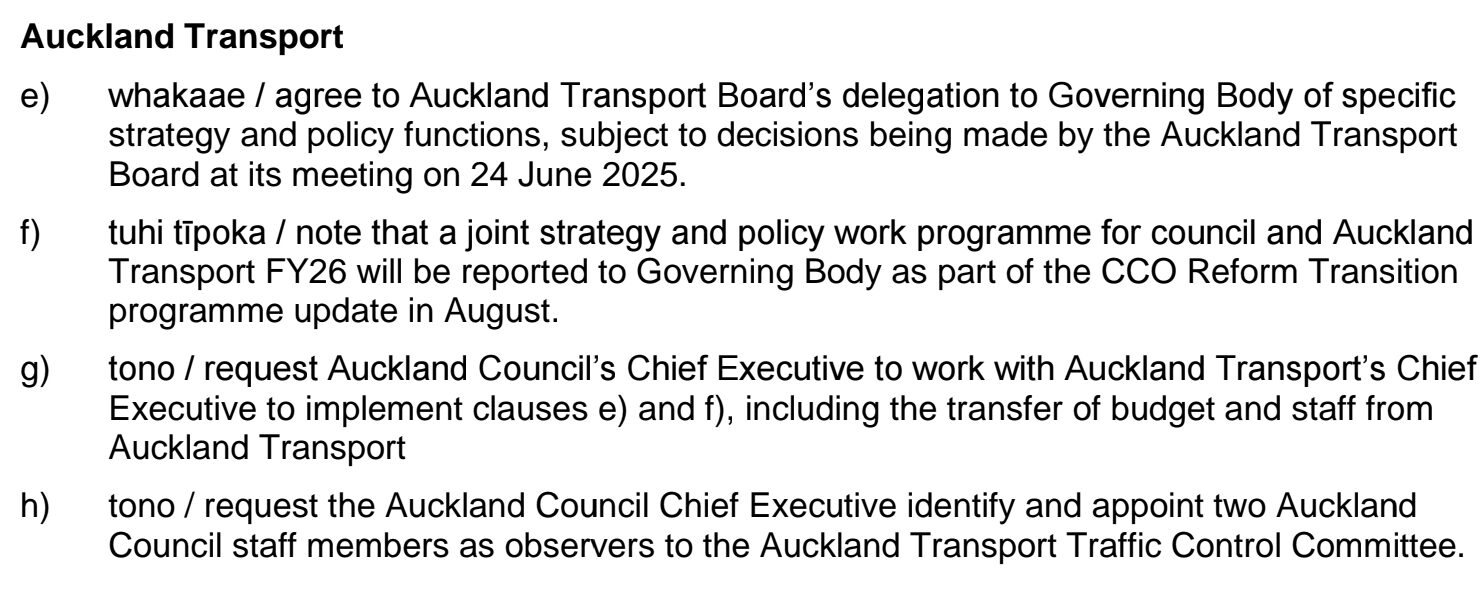 Recommendations from an item on CCO reform at Auckland Council’s Governing Body meeting
Recommendations from an item on CCO reform at Auckland Council’s Governing Body meeting
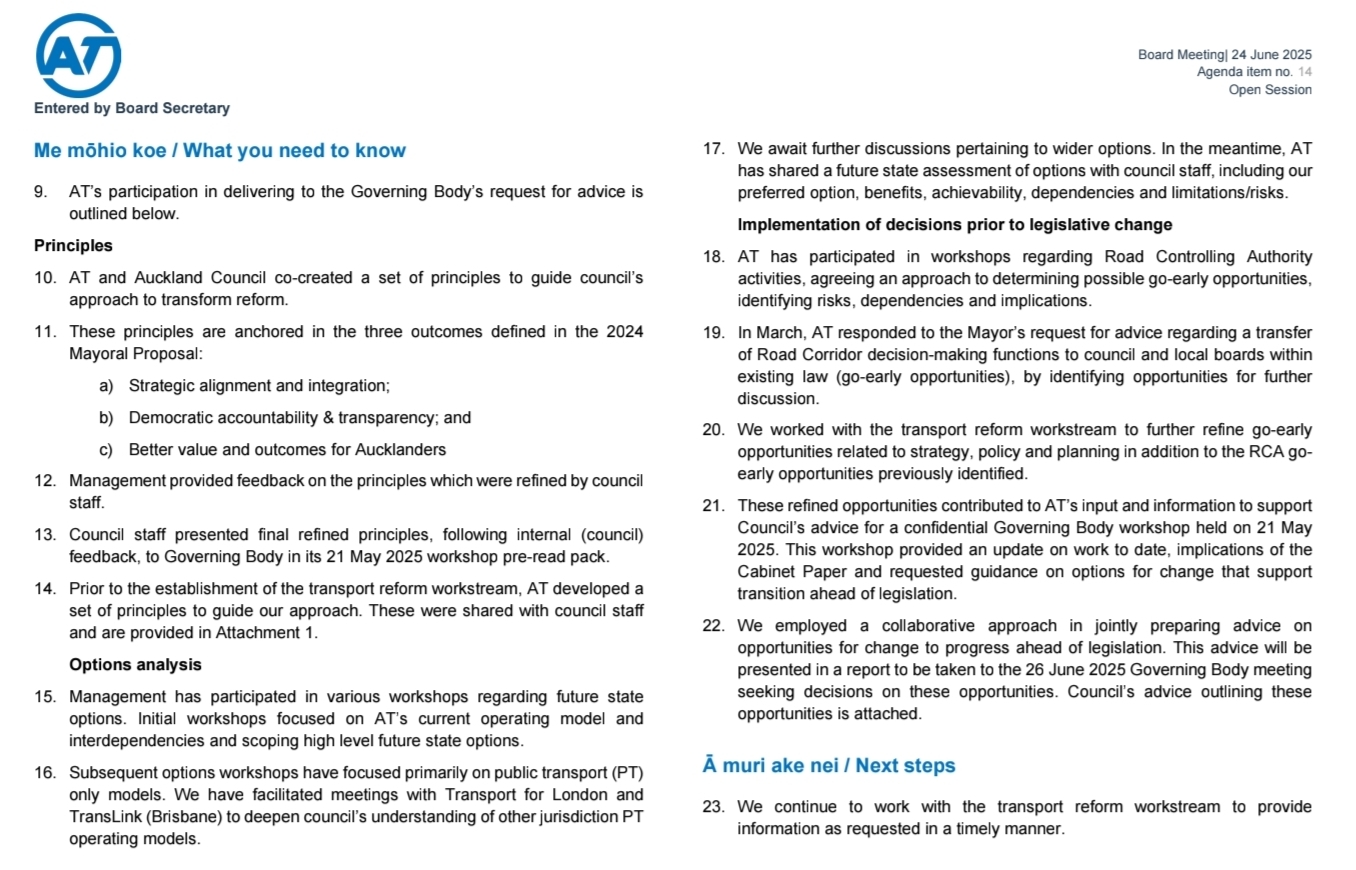 A page taken from an Auckland Transport board paper on transferring functions to Auckland Council
A page taken from an Auckland Transport board paper on transferring functions to Auckland Council
These changes are desperately needed, as over the last 10 years Auckland Transport has demonstrated an inability to align their long-term performance with the expectations of Aucklanders and elected representatives (Councillors and Local Board members). Not only has this resulted in a persistently poor reputation for AT, but that reputation has been well-earned by failing to deliver where improved transport options, safety or climate are concerned.
The best outcome from this upcoming change process would be for Auckland Council to build a strong, competent team of systems-thinkers who collectively possess the various skill sets needed to create a great transport system: Transport planning, yes; but also urban planning and economics, long-term financial management (and understanding how investments today shape expenditure tomorrow), political and social science and communication, environment and health, te ao Māori, and wellbeing, equity, and universal accessibility.
Above all, the team will need a reputable manager who demonstrates relentless positive leadership, and can keep staff motivated as they persevere through predictable challenges to deliver results. Getting things done in transport is never easy, so this needs to be a team that works well together, will work well across organisations, and shares Aucklander’s vision for their city.
Auckland Transport and Auckland Council already have a number of excellent staff who fit the bill, and their local and institutional knowledge is unmatched. They’re the obvious first port of call when seeking members for Auckland’s regional transport super-group.
Turning a transport vision into reality requires perseverance, amongst other skillsets.
There’s a big risk involved, however: The upcoming changes might cut-and-paste problematic parts of Auckland Transport into Auckland Council. Not only would this miss an opportunity to improve things, it could exacerbate existing problems with poor decision making, policy direction and an unhealthy workplace culture—all things which Auckland Council (and Auckland as a region) cannot afford to adopt.
Getting the right people will make-or-break the region’s transport reforms, and should be the issue given the most focus by those, like Mayor Wayne Brown, who want to achieve good long-term outcomes.
It’s also tricky: Getting “the wrong people into the wrong positions” isn’t highlighted as a risk in the advice given to decision makers. It’s one of those subjects that culturally, New Zealanders don’t like to confront, and something that professionally, employees may be hesitant to raise or express.
The worst possible outcome of this process would be to get the wrong people into the wrong positions. If that happens, those people would likely become embedded in the new structure, and the whole ordeal would be futile. To get good results, one key problem at Auckland Transport needs to be resolved.
Some of the risks which Auckland Transport has identified for the transition read as though they are shoe-horning decision makers into retaining existing staff.
Understanding the problem
The first thing to understand is this: Auckland’s many transport challenges, including safety, pollution and traffic congestion, are solvable. Political interference, public reputation and financial constraints are solvable issues, too. In fact, experienced transport professionals already know how to fix these problems, and we know that most of the time, it’s cheaper and easier to implement the solution than it is to maintain the status quo (particularly if we take a long-term view—which is what smart cities do). Where Auckland Transport has been chronically failing is in implementing those solutions.
One of the interesting cultural ideas that persists within Auckland Transport is the opposite of this: That the organisation is besieged by so many problems, all of which need time and support and resources to manage and which, collectively, make it all but impossible to get things done—particularly big things, like the Transport Emissions Reduction Pathway. Staff are frequently preoccupied with an endless list of constraints on their ability to deliver, and quite rationally resort to tackling “what’s within our control”. This gets reported upwards and results in managers feeling like a Herculean effort is required to really change anything in a substantial manner (short of a Deus-ex-Machina approach where a central-government driven mega-project arrives, with associated central-government mega-funding). Internally, the solutions to Auckland’s transport problems—solutions that are being rolled out in cities right across the world—look to be unattainable. To fix Auckland Transport, we need to understand why this is.
Alongside the siloisation of the organisation, where things like safety and active transport are funded and managed separately to things like engineering and road operations, the barrage of “problems”—which includes everything from shifts in government funding and policy, to extreme weather events, to unhelpful text messages between high-ranking politicians and senior staff—create conditions which strongly favour business as usual.
Business as usual is a safe and steady approach which produces reliable results. But there’s a big problem: Those results are reliably the wrong results. They don’t track towards the long-term outcomes that the people of Auckland need their transport agency to achieve, or what elected representatives expect big budgets of ratepayer money to deliver.
Those outcomes are outlined in the Auckland Plan 2050, described by Auckland Council as “our long-term spatial plan to ensure Auckland grows in a way that will meet the opportunities and challenges of the future.”
This well-considered and widely-consulted plan is the best resource for understanding the long-term vision for the region, as it doesn’t suffer from the back-and-forth of 3-year election cycles, or from the recency and awareness biases of yearly key-performance-indicators and Mayoral letters of expectation. Good strategy is about achieving the big-picture, long-term stuff, while tactics respond to the year-to-year zeitgeist of politics and media.
The Auckland Plan was developed in 2018 and includes 3 key directions and 7 focus areas which Auckland Transport should be delivering on, and against which long-term success can be evaluated. These are:
- Direction 1: Maximise safety, environmental protection and emissions reduction
- Direction 2: Better connect people, places, goods and services
- Direction 3: Increase genuine travel choices for a healthy, vibrant and equitable Auckland
And the focus areas:
- Make better use of existing transport networks
- Target new transport investment to the most significant challenges
- Maximise the benefits of new transport technology
- Make walking, cycling and public transport the preferred choices for many more Aucklanders
- Better integrate land-use and transport
- Move to a safe transport system free from death and serious injury
- Develop a sustainable and resilient transport system
Without spending too much time on them, it’s fairly easy to identify that Auckland Transport hasn’t been delivering strongly to these outcomes, and in some cases measures up very poorly.
Take the first direction, for instance: Maximise safety, environmental protection and emissions reduction—literally the number one thing AT should be working towards.
Almost every year since adopting their Vision Zero policy, AT have watered down the target for reducing deaths and serious injuries (as reported in the key performance indicators contained within their annual statements of intent).
Auckland Transport have consistently failed to deliver critical aspects of the Vision Zero programme—such as effective advocacy and education, or physical engineering to promote mode-shift to active travel—and as a result, have managed to lose public and political support for road safety, leading to the abandonment of their award-winning safe speeds programme and the effective (and hopefully temporary) demise of Vision Zero. It’s worth highlighting that this isn’t an issue with the road safety team—who operate to the best of their ability from inside an organisational silo with limited resourcing—but of the organisation at a broader scale for failing to effectively adopt supporting actions outside of the road safety team and across the wider organisation—principally communication and engineering strategies.
Auckland Transport has historically been provided with advice on how to navigate the delivery of transformative programmes like the rollout of Vision Zero, such as this page from the 2021 report on Safety Business Improvement rollout. However, unless it’s adopted at a strategic level across the organisation, this advice is of little use.
AT have also all but shunned their climate responsibilities, with a “don’t ask, don’t tell” attitude to talking about transport system pollution and delivery on Auckland’s climate plan. In fact, Auckland Transport doesn’t currently have anybody whose job it is to monitor or reduce transport system emissions, nor have they assembled a leadership team to implement the emissions reduction pathway, nor do they have a public-facing communications campaign to build support for necessary changes, nor do they report back to Council on emissions reduction progress (some level of accounting is sure to come under AT’s Climate Transition Plan, but this is likely to focus on corporate emissions and not the whole-of-system measures AT are responsible for).
It’s worth mentioning that climate breakdown isn’t a political problem that can be assuaged with talking points or deferred until it’s no longer a priority. Carbon pollution is a physics problem, and the longer Auckland Transport takes to deal with it responsibly, the more difficult and expensive that dealing becomes. AT’s current approach to “maximising emissions reduction” seems to be a combination of deflection, denial and delay. One thing they’re definitely not doing is delivering.
Auckland Transport’s climate strategy as captured by the three wise monkeys at the Tōshō-gū shrine in Nikkō, Japan
For many staff at Auckland Transport, these big-ticket outcomes seem so far removed from their day-to-day jobs that it’s fairly easy to dismiss them as an unnecessary distraction from the task at hand. And that’s a fair thing to do: If everybody had to consider every long-term consequence of every interaction across the transport system, they’d spend all day conceptualising, modelling, data-analysing, consulting and theorising; and probably get a lot less done (those in the industry know that enough of all that stuff happens already!)
That’s why a credible strategy for achieving long-term outcomes is critical for an organisation as big as Auckland Transport, an organisation tasked with managing a complex regional transport system for what will soon be 2 million people. That strategy needs to be translated into policy, and that policy needs to guide planning, funding and investment decisions, so that resources are effectively allocated in a way that will resolve the many interrelated problems that complex systems inherently have.
Auckland’s transport problems are solvable. Experienced transport professionals know what the solutions are and we know that implementing them will lead to better results across the board.
We know that it’s possible to reduce emissions and improve safety, and that doing so will reduce transport expenditure and help solve traffic congestion and accessibility problems. We know that getting this stuff done requires ongoing socialisation and community engagement, to maintain public support. We know that Auckland Transport’s reputation can be improved by delivering these solutions, because they align with what Aucklanders value for their city. And we know that political interference can change into political support, making funding much easier to access—but only if Auckland Transport works towards a positive vision that Aucklanders and their representatives can get behind.
The first problem to tackle (the real problem—the one which any restructure or institutional reshuffle needs to solve) is that, for whatever reason, Auckland Transport has never developed nor delivered on a strategy to make all this happen.
The role of Strategy
In a well-managed organisation, people shouldn’t feel like they’re fighting an endless flood of constraints. With good strategy and appropriate resource allocation, alongside strong leadership and a clear vision, it becomes obvious how staff can contribute towards the bigger goal. Staff are empowered by boundaries which narrow their focus towards effectiveness, rather than feeling frustrated or disenfranchised by problems over which they have little or no control.
On the flipside, it’s fairly easy to tell when an organisation lacks cohesive strategy: When senior staff are questioned about long-term objectives, the responses will highlight problems, constraints, and short-term issues, rather than detailing which part of the organisation has been given the task of solving the problem, and how they’re going to go about doing so. An organisation which lacks strategy will speak in excuses instead of actions.
When Auckland Transport’s senior officers are questioned by Auckland Council on the big-ticket items like safety and emissions—month after month, year after year—those AT officers tend to respond with excuses. The excuses are so regular and reliable that it’s possible to play “AT excuse bingo” at any committee meeting or workshop where Auckland Transport senior managers front up to answer questions.
The most common problems AT use as a non-delivery crutch are:
- Funding constraints
- Shifting policy direction
- Opposition to a project, usually from some fringe group or figure
- Organisational capacity or capability limitations
- Project sequencing or integration issues
- Until recently, COVID-19 or the Auckland Anniversary floods
AT excuse bingo: Bring it along to the next Transport, Resilience and Infrastructure Committee meeting!
But here’s the thing: The role of strategy and policy is to mitigate and minimise these potential issues and help senior staff navigate a pathway through them, which in turn helps managers delegate empowering actions across the organisation. Auckland Transport shouldn’t be seeing the same issues coming up time and time again, because the problems are predictable—and it’s their job to solve them. Auckland Transport exists to get us moving ahead, not to keep us running on a predictable-problem treadmill.
The consistent pattern of excuse-making around long-term objectives makes it clear: Something’s going very wrong with AT’s internal strategy department.
Because many of the people who develop and advise on strategy are also involved in policy and planning, and because the organisation is structured so that strategic decisions cascade outwards, poor strategy becomes bad policy and bad investment.
By the time policy is written and funding is allocated, other teams across the organisation find only constraints and challenges, rather than pathways designed to help them achieve success. The end results speak for themselves.
A venn diagramme depicting the different groups of people involved in cause and resolve our transport problems.
An opportunity for change
Thankfully, the items presented to the AT board and Auckland Council’s governing body get to the heart of the issue, and the process calls for strategy and policy functions to move back to Auckland Council (it’s unclear why this wasn’t always the case). Worryingly, the item also mentions a transfer of AT staff to go along with these duties.
As previously noted, there are some brilliant people at Auckland Transport. But there are also some problematic parts of the organisation, and sometimes getting better results requires, quite bluntly, getting better people.
The transfer of strategy and policy to Auckland Council presents a once-in-a-decade opportunity to solve some critical systemic problems that have been holding the region back and making Auckland Transport, as a whole, much less effective.
Instead of taking the part of Auckland Transport that clearly isn’t working and installing it into Auckland Council (which simply moves the problem around, but doesn’t solve it), a much better option will be for those involved in the change process to focus on building a new, highly-capable team. Recruiting widely (including internationally) and selecting for the right mix of skills should produce a team that can confidently navigate Auckland’s transport problems—getting transport delivery off of the predictable-problem treadmill, and steering the Auckland region towards consistently great transport outcomes.
This post, like all our work, is brought to you by the Greater Auckland crew and made possible by generous donations from our readers and fans. If you’d like to support our work, you can join our circle of supporters here, or support us on Substack!

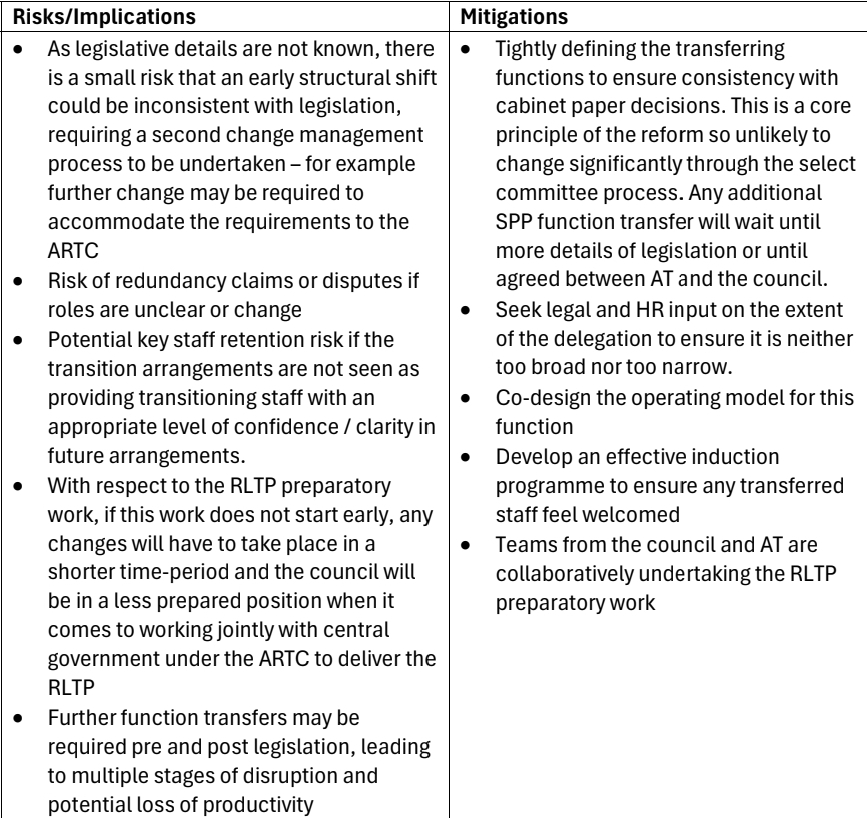
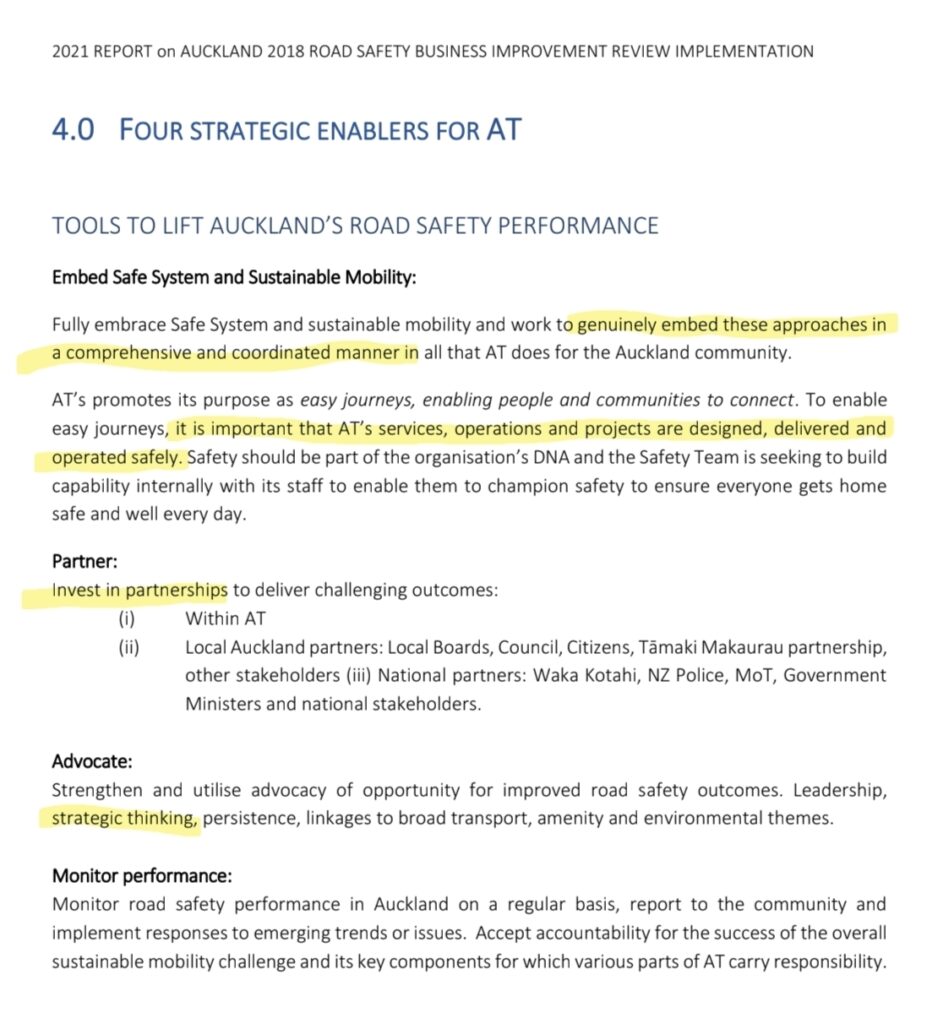

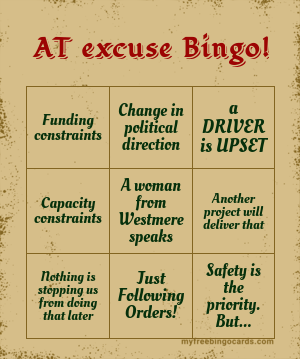
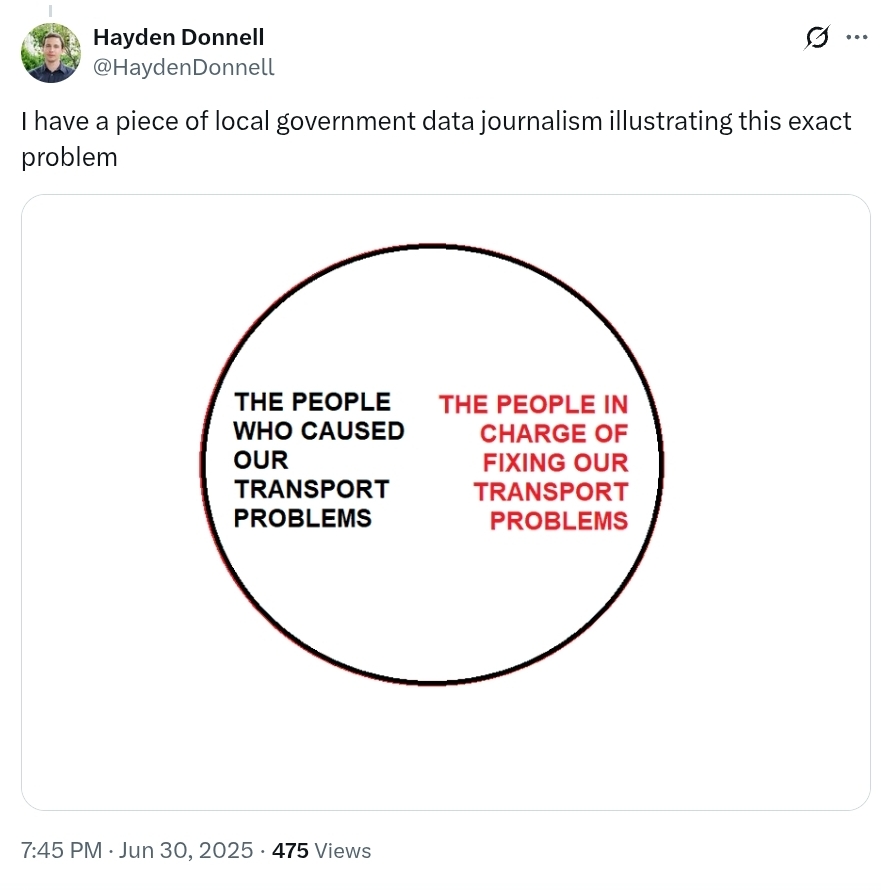

 Processing...
Processing...
Thanks, Tim. A very well argued post. The sort of thing large organisations would pay McKinsey millions for and through your diligence AC get it for free. I hope they have the decency to read, consider and follow your advice. After all the most important decision any manager makes is the hiring decision.
Great post Tim. I would argue it is probably worth naming who the ‘wrong people’ in AT currently are. For my money it would be [redacted -editor, GA does not support doxxing]
I know the mayro has expressed his desire to see Stacey Van Der Putten in the top role and from my experience with her she has been great.
It will be really interesting to see how Local Boards are empowered to move from ‘advocacy’ to ‘decision makers’ on local roads and how agile the new system will be at responding to their desires.
Our city’s biggest problem is that it is big. The biggest problem for a big city, as Los Angeles is also aware, are cars. Modern cities destroy cars, and we should too. With the Central Rail Link, we will be able to move by train more easily, and driving excuses should start to disappear.
I can still drive, but I have not for a few years now, and it is the biggest single reliever of stress that I have encountered in my four or so decades walking this earth.
Live in an apartment, walk everywhere, train to cool places with a connecting bus, do it with your kids, enjoy your time with your kids, not fighting traffic, and life will become a pleasure. Except when you inhale too deeply walking near the toxic gas emitters, but I have been doing that for my entire life, and although I am sure my brain is filled with soft plastic and carbon emission damage, it remains relatively functional, in my opinion.
bah humbug
This seems utterly wrongheaded to me. The whole article is about how policy and strategy aren’t the problem, it’s implementation. But we’re aiming to give policy and strategy back to the elected representatives, who “expectations” – as Wayne Brown’s text messages indicate – are either internally contradictory or straight out hostile to public transit and liveability.
I keep asking people to remember that there’s a *reason* those people were frozen out of setting strategy when AT was set up – because, when the elected representatives ran transport policy, Auckland regressed into the dark ages with motorway madness and they twice tried to make Waitemata Station impossible.
AT needs an internal purge of the “computer says no” types, not to – for example – give Mike Lee the power to put train stations where he wants them, Wayne Brown to tear up the GNR cycle lanes, etc.
I think you highlight a very relevant risk, Daphne. I wish AT had worked out in its current form, but unfortunately the current strategy team tie things in knots before the rest of the organisation even gets started on them, and it’s made the organisation largely inffective.
Political strategy is, perhaps, a post for another day.
So much of the delivery failures from AT are down to elements who just don’t believe in certain modes being valid – https://thespinoff.co.nz/society/28-02-2023/at-cycling-seminar-derailed-by-at-employees-hating-on-cyclists and this is compounded by the silo operating culture, ” X school wants a pedestrian crossing to allow children to get to and from school safely – can we do it ?” Engineer considers their KPIs on traffic movement and replies ” No – it will slow traffic down”.
Thanks, Tim. You’ve outlined the problems perfectly. I share Daphne’s concern about the solution, given Council’s upper management continues to have a BAU focus themselves. Perhaps it can work due to the discontinuity it offers, but only if certain systems settings are in place. Do you think you’ve identified all those systems settings?
Your point is valid that those systems settings could be immediately undermined by the known problem people being simply transferred over to Council.
On this latter point, do you think we can ask Council to confirm that key problem staff at AT will not be appointed? To Council, we could name those who have openly revealed their hand, and where that hand clearly runs counter to the long term goals of Council. (For example, we should be able to expect Council not to employ the staff member whose can’t-do, climate-destroying and I-will-defend-and-impose-car-dependence-until-I-die attitude was laid out so succinctly in an affidavit to the High Court, and whose thinking was debunked, point by point, in the creation of the TERP.)
“.. we should be able to expect Council not to employ the staff member.. ”
– a key indicator, right there.
It might be worth advocating, on a personal basis, to those leading the charge for change.
It’s unlikely Mayor Brown is aware that Auckland Transport is disliked across the board not because every part of the organisation is dysfunctional, but because there are a few key players who derail progress, and a few senior staffers who enable and amplify them.
It’s interesting that the intention is to appoint two Auckland Council staff members as observers to the Traffic Control Committee. I hope the Transport Strategy team can support these staff upfront by explicitly describing the systemic misinterpretations the TCC has been making, and by giving explicit direction to AT to refrain from continuing with these misinterpretations.
Specifically, AT’s TCC understands that it is deciding on whether new traffic controls are “a justified limitation on the right to freedom of movement on roads which will not unduly impede vehicular traffic using the road”. Their error is in their interpretation of the word “unduly”. They have refused to introduce controls that would impede vehicular traffic, because they inaccurately believe safety, emissions reductions and modeshift do not constitute “due” reasons to impede vehicles.
This is at the heart of everything that the TCC is doing wrong, and means AT is, decision after decision, failing to fulfill AT’s statutory obligations to establish traffic controls “for the safe and efficient use of the road network”.
An excellent test of whether the Strategy Team has been given the required tools to enact change at AT, is whether we see all members of the TCC replaced within 3 months.
“an inability to align their long-term performance with the expectations of Aucklanders and elected representatives” – is that even possible? Not all Aucklanders or councillors have the same expectations.
It seems that the active mode people hate AT as much as the road only people. That probably means AT have positioned themselves somewhere near the middle which is where they should be.
If we want them to meet the expectations of elected representatives, we will have them flip flopping every time a new mayor / government are elected. Which is exactly what they were setup not to do.
Personally I think these changes will be a mistake… Not that I think AT are by any means perfect.
Pissing everybody off is the sign of doing everything wrong, not of doing everything right. When you do things well, those who opposed it change their mind, or at least realise other people have benefited and that they themselves were in the minority. There’s heaps of research showing this.
Where there is a conflict between doing one thing well at the expense of doing another thing badly, a ‘trade-off’ position of doing neither thing well enough is a fail for both new idea and status quo. The only good answer is to find how to do both things well, but maybe not in the same place. Funnily enough, AT has a lot of experience at doing that, but not always getting approval for it.
Mmm, there’s truth in that. Mutual benefits would emerge in the same place, though, if AT focused more on vkt reduction in every project. It’s too many vehicles clogging everything up that’s the issue. And your point about not getting approval points is related to the lost opportunity for political independence. By now, there should be 13 years of AT experience on how to use that independence to defend vkt reduction measures, given AC has been instructing them to achieve it for at least this long.
“By now, there should be 13 years of AT experience on how to use that independence to defend vkt reduction measures, given AC has been instructing them to achieve it for at least this long.”
What on earth has the AT Board been doing?
I think there is a delicate balancing act required, and I think it can be done. There are some roads that need improving to help keep traffic flowing better (eg removal of some poorly placed on-road carparks that impede flow). However a key thing to focus on is making public transport more appealing – safer, more reliable, etc. While I know reliability is better with more bus lanes, other things can be done in the short term as well – better advance communications when there are delays (so I don’t leave work to catch a bus that will never turn up), getting priority at traffic lights when running late, and improved use of data and technology. In the last few weeks I’ve still come across a few ghost buses which is very frustrating.
If you take road space from one mode and give it to another, it will piss the others off. You can claim it will decrease overall congestion etc, but that is a long game. Until you get a full network effect, people just see empty buses and cycle lanes that could be used for their cars.
So, do enough in an area to create the network effect quickly. Which is the thinking behind the area by area designs for cycling infrastructure that Kathryn King put in place at AT.
These worked, but instead of management learning from them and stepping up in aspiration, they restructured her out. Just one of many opportunities deliberately lost.
It’s impossible to make everyone happy, especially considering the depth of carbrain here and the gulf between car-only people and active modes people. Trying to appease everyone is how you end up with half-assed infrastructure that doesn’t accomplish anything and pisses everyone off anyway.
“the expectations of Aucklanders and elected representatives” – as expressed in the official regulatory documents stewarded by Council.
No crystal ball required in AT. It’s not rocket surgery.
The functional role of politics is to allocate resources, generally scare financial ones. Where this role is completely captured by politicians there is a risk they over allocate to pet projects (eg Mike Lee’s Parnel station) and/or in favour of their backers (Shane Jones). Where the role is abdicated by politicians by way of citizens’ referenda and similar processes we risk Brexit style outcomes.
The middle road is the ‘empowered bureaucracy’ role chosen for AT where the politicians provide light touch direction and AT uses a combination of citizen consultation and selective hearing wrt direction from their political masters to decide how to allocate the resources they have been given and they appear to do so in a manner that primarily serves the bureaucracy, not the people.
Some politicians quite like this as they get to blame the bureaucracy when things (appear to) go wrong and if they are well enough connected to the bureaucracy they get to over-ride decisions in favour of their special interest groups. All care, no responsibility.
The perfect solution would be a better class of politician who made rational long term decisions with the interests of all Citizens considered and included, then drove the ATs of the world to deliver at best cost.
We don’t live in a perfect world and politics has gotten even messier and more partisan in the last few years so what is a realistic solution?
I tend to agree with Tim, that in this case Auckland Council needs “to build a strong, competent team of systems-thinkers who collectively possess the various skill sets needed to create a great transport system …” Auckland Councillors then need to provide AT with strategic direction and hold it to that direction, not to meddlesome details like the number of road cones in use.
Thanks, Tim, for your contribution.
If you set up good processes you can ensure better outcomes. For example if new ideas go through a rigorous process the useful should be differentiated from the non useful. An important part of this is feedback to the people giving the ideas.
It’s amazing how many ways the authors here can kick down public servants, when it’s pretty evident near-none of them have ever worked in one let alone tried to make a project happen inside them.
It is also incredibly dishonest to avoid mentioning the power of the NLTP to very strongly drive AT towards getting the most funding for the most programme delivery. AT’s Board always follows the transport money, and there sure ain’t any available from anywhere to somehow lower CO2 emissions from this government.
It is also weird to avoid stating that AT were separated by legislation to ensure they weren’t integrated into Auckland Council. They are again being structurally redirected by legislation. At that level, central government not AT itself directs its strategic direction. Does anyone need reminding about the light rail debacle that AT caused by giving the Mayor about an hour of notice before the light rail launch, and then assisting to burn down the Minister of Transport? Dog, meet tail.
Suck it up cupcakes climate change isn’t particularly material to what AT do, nor is it to NZTA. The document quoted was bogus and irrelevant. Blaming AT for not forming a staff committee about it is childish. For the most part AT follow national directives, with the role and power of Auckland Council is getting smaller and smaller other than on maintenance. The NLTF is broke, AC had had its coffers drained by CRL, by higher farebox recovery, and by gaining massive ex-SH1 highway assets in the north.
It’s election season people, so anyone who really thinks there’s real interest on even stronger realignment with Auckland Council, has the ability to put those idea to the public as a candidate and see where it gets them.
If you can’t do that, well, my challenge to you is to go get on the staff of AT and see if you can get something good done.
Hi Ad,
I think your comment perfectly encapsulates a routine AT response (I’m not sure if you work there or not).
There’s some very relevent myth reinforcement there: Such as that the NLTF defines the outcomes (and the classic “funding constraints” excuse), the line on climate being immaterial to what AT does (well yes, that’s the exact problem!—The value of a transport agency in 2025 can be measured almost exclusively by how well they are reducing emissions, and for AT it’s apparently “immaterial”).
There’s also the classic shape of “look at all these problems that affect AT that aren’t the organisations fault!” (Standard-issue deflection)
Except, the things you mention are predominantly within ATs control. If you or AT don’t know how to change those things and prevent then from being recurring problems… You might want to ask a good strategist to come and help you figure them out. Because they aren’t difficult problems, they’re man-made ones, and they can be solved.
But it would take a team of people who were given the task of getting good results for the region’s transport system—like, say, I don’t know… A regional transport agency?—to actually make a plan and get to work solving them. That would be the whole reason the public sector would set up that transport agency and pay those people, really, wouldn’t it?
So if those people came out the other side and said what you just said… Well, that would demonstrate the transport agency isn’t functioning very well.
Which is sort of what this whole piece is about.
Two words, learnt helpless. It’s a feature of most of the public service in this country. Properly a combination of politicians, the heads of departments and agencies, the legislative set up. That drives this culture, Ad and others are just products of that environment
Thanks for illustrating Tim’s point that “Staff are frequently preoccupied with an endless list of constraints on their ability to deliver”
I’ll note some inaccuracies in your comment here so you can correct them: the employment experience of the author, the idea that he’s been “dishonest” (really!), that the AT Board always follows the money (not for innovation or for cycling it doesn’t!)
But this alarming admission needs a more full reply:
“Suck it up cupcakes climate change isn’t particularly material to what AT do”.
The truth is that everything AT does impacts our climate response, including network planning, enforcement, communications, incident response, maintenance, investment, advocacy to central government. If you read the TERP at all, perhaps a defensive mindset was preventing you from picking up new ideas. You’d be better prepared if AT had developed effective strategy for delivering Vision Zero and the TERP, which would have led to training programmes for staff.
“Suck it up cupcakes” is just a classic troll comment, when you know that it will just rile people up and get them really pissed off. It is also fairly irrelevant to the discussion at hand.
I just always think that instead of trying to reinvent the wheel (AT) yet again, find an example of a city where the problem does NOT exist, and copy their set-up. How about Paris, where Mayor Hidalgo has somehow, miraculously, both obliterated the use of cars and simultaneously, managed to make everyone seemingly much much happier at their absence.
How on earth has she managed to do that? It is Paris that we need to learn from, not a tired old ten-times-round-the-block AT / AC stoush.
Paris and has underground metro so some differences to Auckland although ideas should still be looked at
Ah of course, Auckland should merely just have a pre-automobile city centre and 100-year old underground metro system and they’ll be able to solve all current problems.
I’m more interested in seeing What needs fixing for AT.
The membership and scope of a Regional Transport Agency that is not dominated by government directives and NZTA management from Wellington and can fully fund integrated projects and programmes to do the things set out in the Auckland Plan would make a good article.
The ability to secure funding for the things AT wants to do, to follow that Plan, might make for better results.
The rest is (important) detail.
What you are asking for is what the job of the strategy team is.
You should be able to answer your own question by reading the relevant strategy from Auckland Transport, detailing what they need in order to make progress, and how they’re going to go about getting it. But sadly, no such strategy exists.
While it’s an article that could be written, it wouldn’t be useful if there wasn’t anybody in place to make it happen.
Great post, Tim.
Homer Simpson (Mayoral Candidate): “Everybody’s [Public Transport Delivery Organisation] is falling apart except ours. The problem’s [consultation]. Too much [consultation].